Comprehensive Report: Australian Construction Contract Law Analysis
VerifiedAdded on 2023/01/23
|20
|8018
|44
Report
AI Summary
This report provides a detailed overview of Australian construction contract law, addressing key aspects relevant to construction projects. It covers contract formation, scope of work, variations, extensions, and the duties of involved parties. The report examines security of payment, dispute resolution mechanisms including the Victoria Civil and Administrative Tribunal (VCAT), and remedies for breaches. It further explores liquidated damages, contingencies, stakeholder roles, and latent conditions. Regulations such as the National Construction Code and Australian Standards are also considered, alongside various contract types, insurance, and proportionate liability. The analysis extends to areas like misleading conduct, unfair terms, defective works, frustration, and termination, providing a comprehensive understanding of the legal framework governing construction projects in Australia.

Construction Law
Paraphrase This Document
Need a fresh take? Get an instant paraphrase of this document with our AI Paraphraser

Executive summary
The report is focused on the law related to construction contracts in Australia with regard to
various features pertaining to construction projects as far as the law of contract is concerned.
Various aspects of construction contracts have been examined and highlighted in the report
and explained accordingly. The procedures pertaining to the resolution of disputes have also
been taken into account with regard to the providing of a comprehensive solution
accordingly. The functions of Victoria Central Administrative Tribunal have also been taken
into consideration. The aspects related to standard and non-standard forms of contract are
also discussed and demonstrated.
The report is focused on the law related to construction contracts in Australia with regard to
various features pertaining to construction projects as far as the law of contract is concerned.
Various aspects of construction contracts have been examined and highlighted in the report
and explained accordingly. The procedures pertaining to the resolution of disputes have also
been taken into account with regard to the providing of a comprehensive solution
accordingly. The functions of Victoria Central Administrative Tribunal have also been taken
into consideration. The aspects related to standard and non-standard forms of contract are
also discussed and demonstrated.
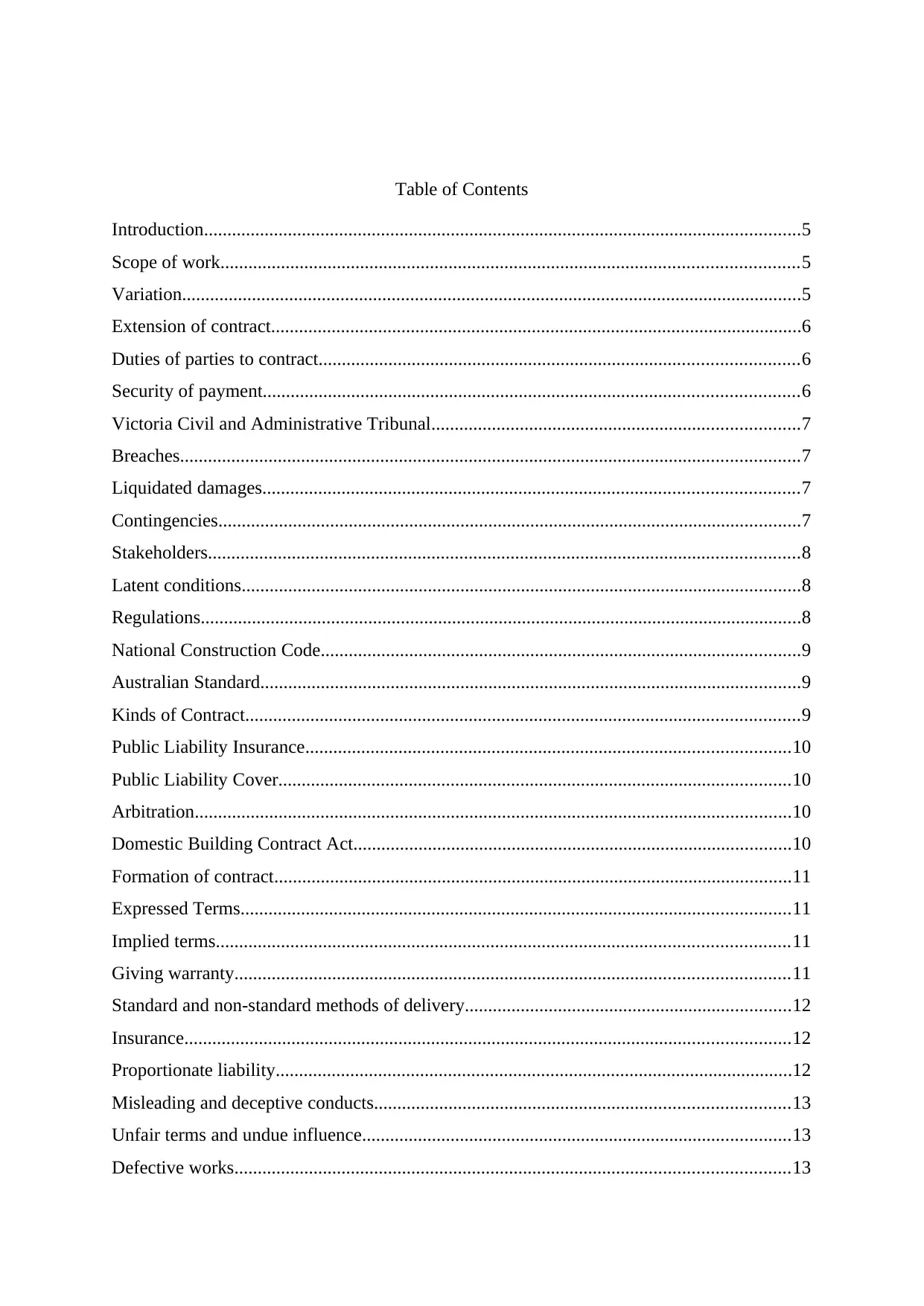
Table of Contents
Introduction................................................................................................................................5
Scope of work............................................................................................................................5
Variation.....................................................................................................................................5
Extension of contract..................................................................................................................6
Duties of parties to contract.......................................................................................................6
Security of payment...................................................................................................................6
Victoria Civil and Administrative Tribunal...............................................................................7
Breaches.....................................................................................................................................7
Liquidated damages...................................................................................................................7
Contingencies.............................................................................................................................7
Stakeholders...............................................................................................................................8
Latent conditions........................................................................................................................8
Regulations.................................................................................................................................8
National Construction Code.......................................................................................................9
Australian Standard....................................................................................................................9
Kinds of Contract.......................................................................................................................9
Public Liability Insurance........................................................................................................10
Public Liability Cover..............................................................................................................10
Arbitration................................................................................................................................10
Domestic Building Contract Act..............................................................................................10
Formation of contract...............................................................................................................11
Expressed Terms......................................................................................................................11
Implied terms...........................................................................................................................11
Giving warranty.......................................................................................................................11
Standard and non-standard methods of delivery......................................................................12
Insurance..................................................................................................................................12
Proportionate liability...............................................................................................................12
Misleading and deceptive conducts.........................................................................................13
Unfair terms and undue influence............................................................................................13
Defective works.......................................................................................................................13
Introduction................................................................................................................................5
Scope of work............................................................................................................................5
Variation.....................................................................................................................................5
Extension of contract..................................................................................................................6
Duties of parties to contract.......................................................................................................6
Security of payment...................................................................................................................6
Victoria Civil and Administrative Tribunal...............................................................................7
Breaches.....................................................................................................................................7
Liquidated damages...................................................................................................................7
Contingencies.............................................................................................................................7
Stakeholders...............................................................................................................................8
Latent conditions........................................................................................................................8
Regulations.................................................................................................................................8
National Construction Code.......................................................................................................9
Australian Standard....................................................................................................................9
Kinds of Contract.......................................................................................................................9
Public Liability Insurance........................................................................................................10
Public Liability Cover..............................................................................................................10
Arbitration................................................................................................................................10
Domestic Building Contract Act..............................................................................................10
Formation of contract...............................................................................................................11
Expressed Terms......................................................................................................................11
Implied terms...........................................................................................................................11
Giving warranty.......................................................................................................................11
Standard and non-standard methods of delivery......................................................................12
Insurance..................................................................................................................................12
Proportionate liability...............................................................................................................12
Misleading and deceptive conducts.........................................................................................13
Unfair terms and undue influence............................................................................................13
Defective works.......................................................................................................................13
⊘ This is a preview!⊘
Do you want full access?
Subscribe today to unlock all pages.

Trusted by 1+ million students worldwide
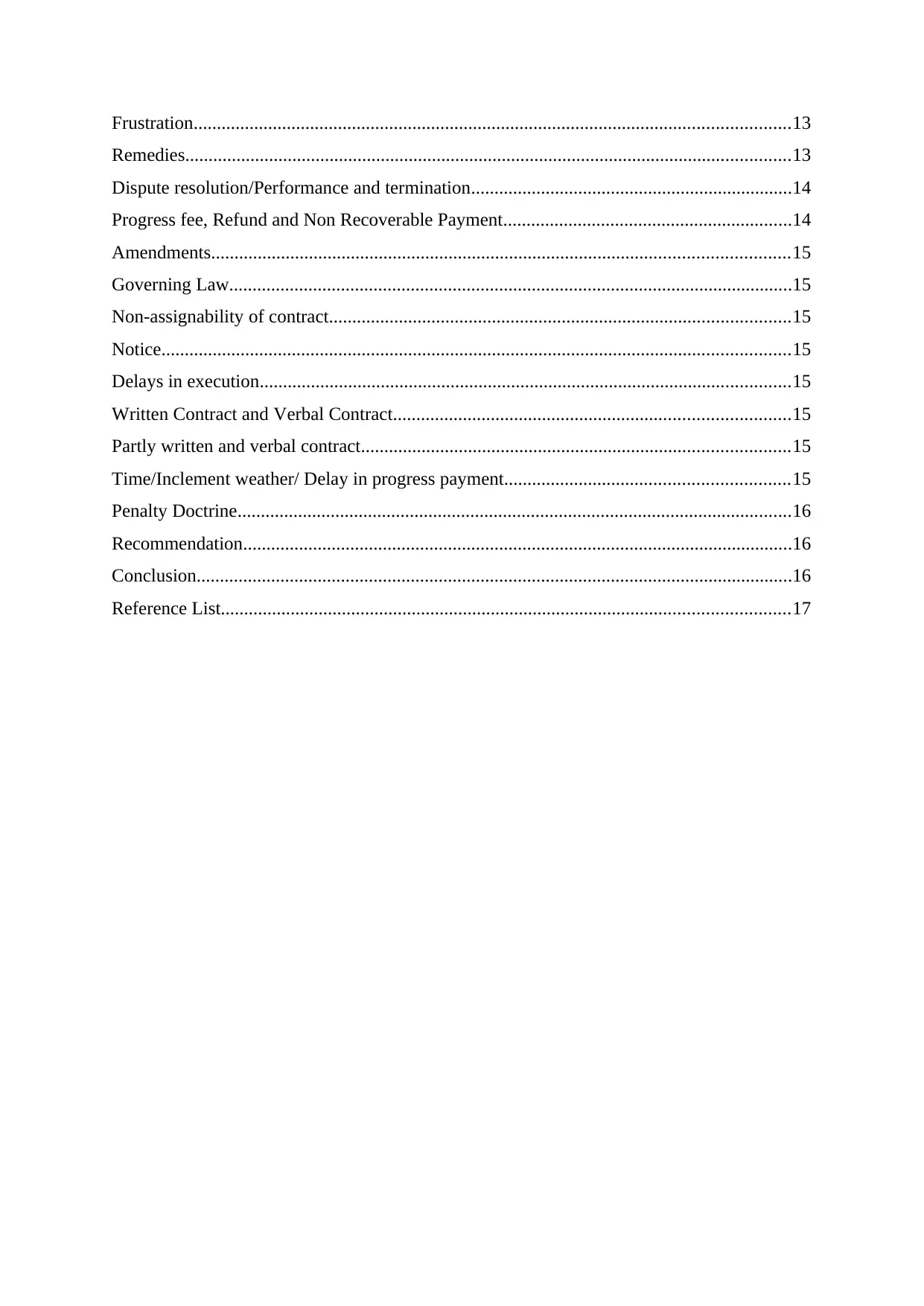
Frustration................................................................................................................................13
Remedies..................................................................................................................................13
Dispute resolution/Performance and termination.....................................................................14
Progress fee, Refund and Non Recoverable Payment..............................................................14
Amendments............................................................................................................................15
Governing Law.........................................................................................................................15
Non-assignability of contract...................................................................................................15
Notice.......................................................................................................................................15
Delays in execution..................................................................................................................15
Written Contract and Verbal Contract.....................................................................................15
Partly written and verbal contract............................................................................................15
Time/Inclement weather/ Delay in progress payment.............................................................15
Penalty Doctrine.......................................................................................................................16
Recommendation......................................................................................................................16
Conclusion................................................................................................................................16
Reference List..........................................................................................................................17
Remedies..................................................................................................................................13
Dispute resolution/Performance and termination.....................................................................14
Progress fee, Refund and Non Recoverable Payment..............................................................14
Amendments............................................................................................................................15
Governing Law.........................................................................................................................15
Non-assignability of contract...................................................................................................15
Notice.......................................................................................................................................15
Delays in execution..................................................................................................................15
Written Contract and Verbal Contract.....................................................................................15
Partly written and verbal contract............................................................................................15
Time/Inclement weather/ Delay in progress payment.............................................................15
Penalty Doctrine.......................................................................................................................16
Recommendation......................................................................................................................16
Conclusion................................................................................................................................16
Reference List..........................................................................................................................17
Paraphrase This Document
Need a fresh take? Get an instant paraphrase of this document with our AI Paraphraser
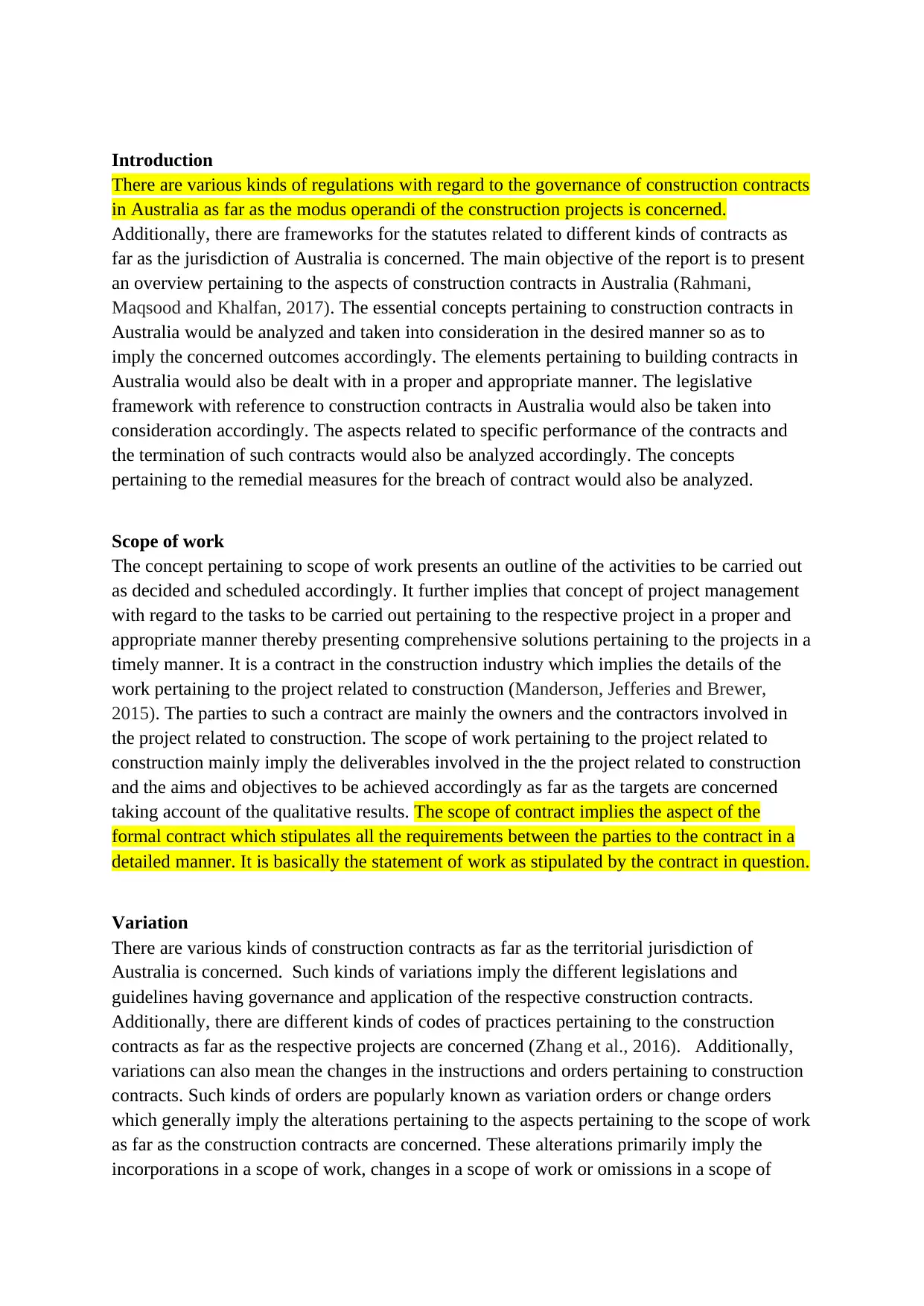
Introduction
There are various kinds of regulations with regard to the governance of construction contracts
in Australia as far as the modus operandi of the construction projects is concerned.
Additionally, there are frameworks for the statutes related to different kinds of contracts as
far as the jurisdiction of Australia is concerned. The main objective of the report is to present
an overview pertaining to the aspects of construction contracts in Australia (Rahmani,
Maqsood and Khalfan, 2017). The essential concepts pertaining to construction contracts in
Australia would be analyzed and taken into consideration in the desired manner so as to
imply the concerned outcomes accordingly. The elements pertaining to building contracts in
Australia would also be dealt with in a proper and appropriate manner. The legislative
framework with reference to construction contracts in Australia would also be taken into
consideration accordingly. The aspects related to specific performance of the contracts and
the termination of such contracts would also be analyzed accordingly. The concepts
pertaining to the remedial measures for the breach of contract would also be analyzed.
Scope of work
The concept pertaining to scope of work presents an outline of the activities to be carried out
as decided and scheduled accordingly. It further implies that concept of project management
with regard to the tasks to be carried out pertaining to the respective project in a proper and
appropriate manner thereby presenting comprehensive solutions pertaining to the projects in a
timely manner. It is a contract in the construction industry which implies the details of the
work pertaining to the project related to construction (Manderson, Jefferies and Brewer,
2015). The parties to such a contract are mainly the owners and the contractors involved in
the project related to construction. The scope of work pertaining to the project related to
construction mainly imply the deliverables involved in the the project related to construction
and the aims and objectives to be achieved accordingly as far as the targets are concerned
taking account of the qualitative results. The scope of contract implies the aspect of the
formal contract which stipulates all the requirements between the parties to the contract in a
detailed manner. It is basically the statement of work as stipulated by the contract in question.
Variation
There are various kinds of construction contracts as far as the territorial jurisdiction of
Australia is concerned. Such kinds of variations imply the different legislations and
guidelines having governance and application of the respective construction contracts.
Additionally, there are different kinds of codes of practices pertaining to the construction
contracts as far as the respective projects are concerned (Zhang et al., 2016). Additionally,
variations can also mean the changes in the instructions and orders pertaining to construction
contracts. Such kinds of orders are popularly known as variation orders or change orders
which generally imply the alterations pertaining to the aspects pertaining to the scope of work
as far as the construction contracts are concerned. These alterations primarily imply the
incorporations in a scope of work, changes in a scope of work or omissions in a scope of
There are various kinds of regulations with regard to the governance of construction contracts
in Australia as far as the modus operandi of the construction projects is concerned.
Additionally, there are frameworks for the statutes related to different kinds of contracts as
far as the jurisdiction of Australia is concerned. The main objective of the report is to present
an overview pertaining to the aspects of construction contracts in Australia (Rahmani,
Maqsood and Khalfan, 2017). The essential concepts pertaining to construction contracts in
Australia would be analyzed and taken into consideration in the desired manner so as to
imply the concerned outcomes accordingly. The elements pertaining to building contracts in
Australia would also be dealt with in a proper and appropriate manner. The legislative
framework with reference to construction contracts in Australia would also be taken into
consideration accordingly. The aspects related to specific performance of the contracts and
the termination of such contracts would also be analyzed accordingly. The concepts
pertaining to the remedial measures for the breach of contract would also be analyzed.
Scope of work
The concept pertaining to scope of work presents an outline of the activities to be carried out
as decided and scheduled accordingly. It further implies that concept of project management
with regard to the tasks to be carried out pertaining to the respective project in a proper and
appropriate manner thereby presenting comprehensive solutions pertaining to the projects in a
timely manner. It is a contract in the construction industry which implies the details of the
work pertaining to the project related to construction (Manderson, Jefferies and Brewer,
2015). The parties to such a contract are mainly the owners and the contractors involved in
the project related to construction. The scope of work pertaining to the project related to
construction mainly imply the deliverables involved in the the project related to construction
and the aims and objectives to be achieved accordingly as far as the targets are concerned
taking account of the qualitative results. The scope of contract implies the aspect of the
formal contract which stipulates all the requirements between the parties to the contract in a
detailed manner. It is basically the statement of work as stipulated by the contract in question.
Variation
There are various kinds of construction contracts as far as the territorial jurisdiction of
Australia is concerned. Such kinds of variations imply the different legislations and
guidelines having governance and application of the respective construction contracts.
Additionally, there are different kinds of codes of practices pertaining to the construction
contracts as far as the respective projects are concerned (Zhang et al., 2016). Additionally,
variations can also mean the changes in the instructions and orders pertaining to construction
contracts. Such kinds of orders are popularly known as variation orders or change orders
which generally imply the alterations pertaining to the aspects pertaining to the scope of work
as far as the construction contracts are concerned. These alterations primarily imply the
incorporations in a scope of work, changes in a scope of work or omissions in a scope of
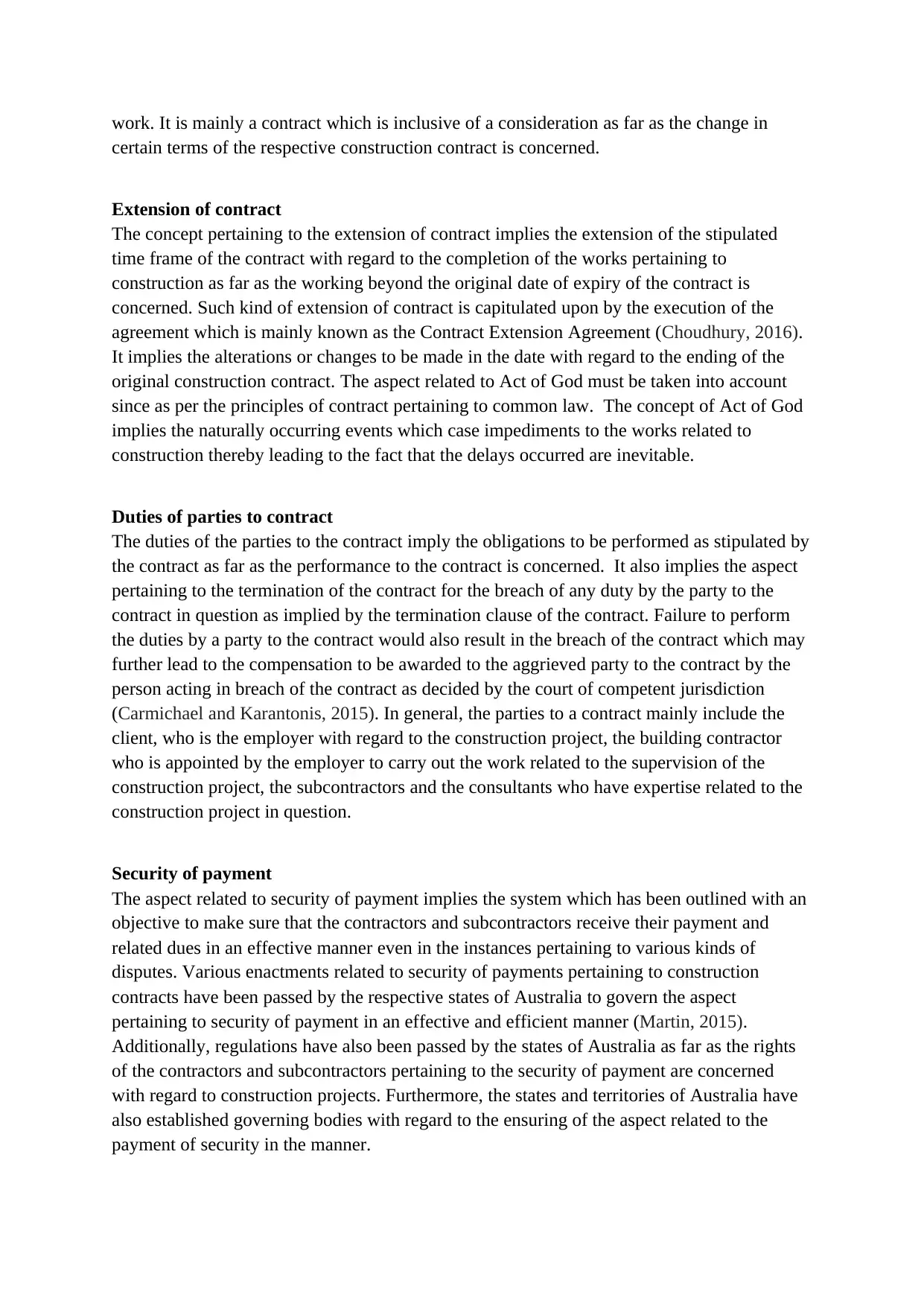
work. It is mainly a contract which is inclusive of a consideration as far as the change in
certain terms of the respective construction contract is concerned.
Extension of contract
The concept pertaining to the extension of contract implies the extension of the stipulated
time frame of the contract with regard to the completion of the works pertaining to
construction as far as the working beyond the original date of expiry of the contract is
concerned. Such kind of extension of contract is capitulated upon by the execution of the
agreement which is mainly known as the Contract Extension Agreement (Choudhury, 2016).
It implies the alterations or changes to be made in the date with regard to the ending of the
original construction contract. The aspect related to Act of God must be taken into account
since as per the principles of contract pertaining to common law. The concept of Act of God
implies the naturally occurring events which case impediments to the works related to
construction thereby leading to the fact that the delays occurred are inevitable.
Duties of parties to contract
The duties of the parties to the contract imply the obligations to be performed as stipulated by
the contract as far as the performance to the contract is concerned. It also implies the aspect
pertaining to the termination of the contract for the breach of any duty by the party to the
contract in question as implied by the termination clause of the contract. Failure to perform
the duties by a party to the contract would also result in the breach of the contract which may
further lead to the compensation to be awarded to the aggrieved party to the contract by the
person acting in breach of the contract as decided by the court of competent jurisdiction
(Carmichael and Karantonis, 2015). In general, the parties to a contract mainly include the
client, who is the employer with regard to the construction project, the building contractor
who is appointed by the employer to carry out the work related to the supervision of the
construction project, the subcontractors and the consultants who have expertise related to the
construction project in question.
Security of payment
The aspect related to security of payment implies the system which has been outlined with an
objective to make sure that the contractors and subcontractors receive their payment and
related dues in an effective manner even in the instances pertaining to various kinds of
disputes. Various enactments related to security of payments pertaining to construction
contracts have been passed by the respective states of Australia to govern the aspect
pertaining to security of payment in an effective and efficient manner (Martin, 2015).
Additionally, regulations have also been passed by the states of Australia as far as the rights
of the contractors and subcontractors pertaining to the security of payment are concerned
with regard to construction projects. Furthermore, the states and territories of Australia have
also established governing bodies with regard to the ensuring of the aspect related to the
payment of security in the manner.
certain terms of the respective construction contract is concerned.
Extension of contract
The concept pertaining to the extension of contract implies the extension of the stipulated
time frame of the contract with regard to the completion of the works pertaining to
construction as far as the working beyond the original date of expiry of the contract is
concerned. Such kind of extension of contract is capitulated upon by the execution of the
agreement which is mainly known as the Contract Extension Agreement (Choudhury, 2016).
It implies the alterations or changes to be made in the date with regard to the ending of the
original construction contract. The aspect related to Act of God must be taken into account
since as per the principles of contract pertaining to common law. The concept of Act of God
implies the naturally occurring events which case impediments to the works related to
construction thereby leading to the fact that the delays occurred are inevitable.
Duties of parties to contract
The duties of the parties to the contract imply the obligations to be performed as stipulated by
the contract as far as the performance to the contract is concerned. It also implies the aspect
pertaining to the termination of the contract for the breach of any duty by the party to the
contract in question as implied by the termination clause of the contract. Failure to perform
the duties by a party to the contract would also result in the breach of the contract which may
further lead to the compensation to be awarded to the aggrieved party to the contract by the
person acting in breach of the contract as decided by the court of competent jurisdiction
(Carmichael and Karantonis, 2015). In general, the parties to a contract mainly include the
client, who is the employer with regard to the construction project, the building contractor
who is appointed by the employer to carry out the work related to the supervision of the
construction project, the subcontractors and the consultants who have expertise related to the
construction project in question.
Security of payment
The aspect related to security of payment implies the system which has been outlined with an
objective to make sure that the contractors and subcontractors receive their payment and
related dues in an effective manner even in the instances pertaining to various kinds of
disputes. Various enactments related to security of payments pertaining to construction
contracts have been passed by the respective states of Australia to govern the aspect
pertaining to security of payment in an effective and efficient manner (Martin, 2015).
Additionally, regulations have also been passed by the states of Australia as far as the rights
of the contractors and subcontractors pertaining to the security of payment are concerned
with regard to construction projects. Furthermore, the states and territories of Australia have
also established governing bodies with regard to the ensuring of the aspect related to the
payment of security in the manner.
⊘ This is a preview!⊘
Do you want full access?
Subscribe today to unlock all pages.

Trusted by 1+ million students worldwide
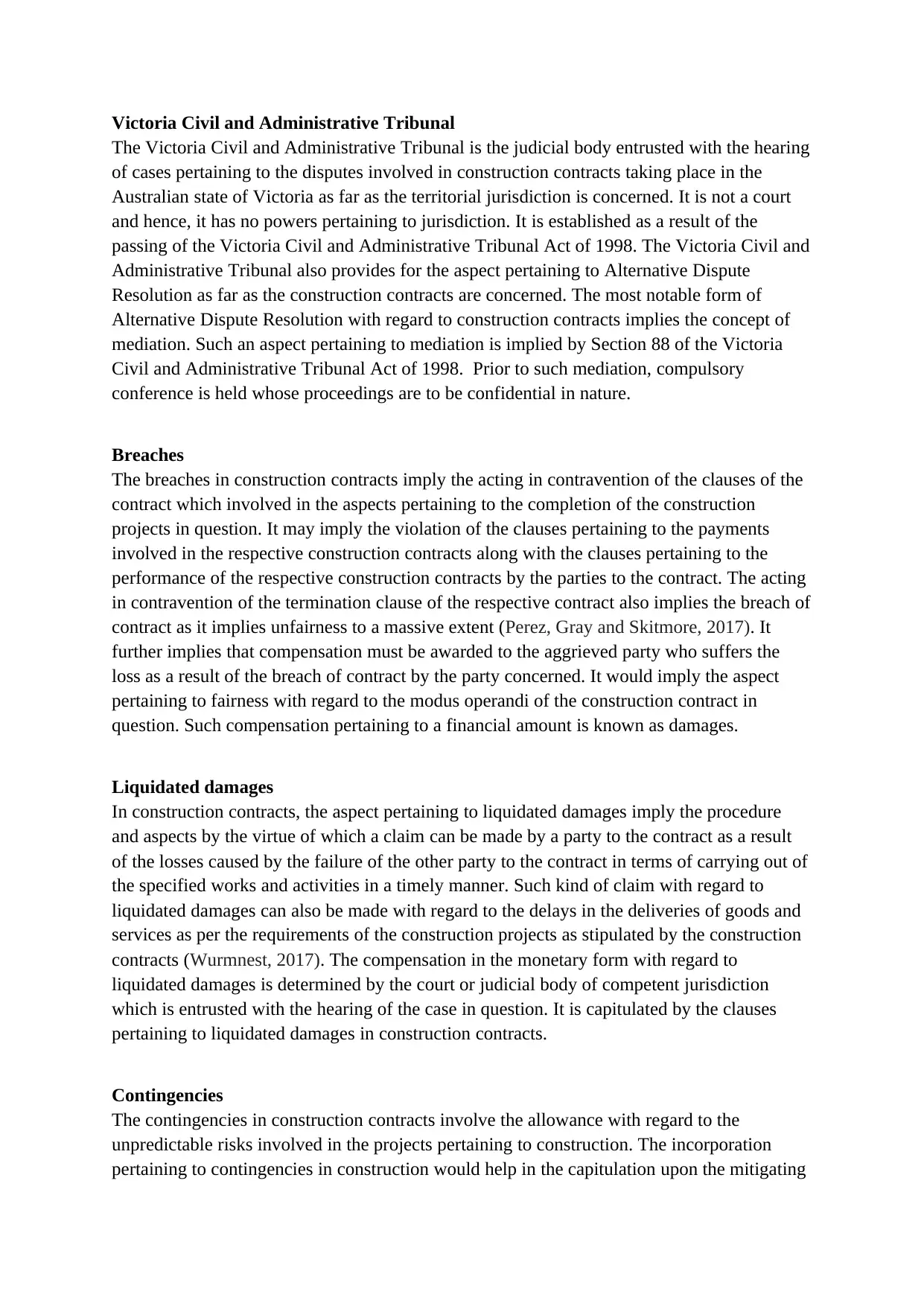
Victoria Civil and Administrative Tribunal
The Victoria Civil and Administrative Tribunal is the judicial body entrusted with the hearing
of cases pertaining to the disputes involved in construction contracts taking place in the
Australian state of Victoria as far as the territorial jurisdiction is concerned. It is not a court
and hence, it has no powers pertaining to jurisdiction. It is established as a result of the
passing of the Victoria Civil and Administrative Tribunal Act of 1998. The Victoria Civil and
Administrative Tribunal also provides for the aspect pertaining to Alternative Dispute
Resolution as far as the construction contracts are concerned. The most notable form of
Alternative Dispute Resolution with regard to construction contracts implies the concept of
mediation. Such an aspect pertaining to mediation is implied by Section 88 of the Victoria
Civil and Administrative Tribunal Act of 1998. Prior to such mediation, compulsory
conference is held whose proceedings are to be confidential in nature.
Breaches
The breaches in construction contracts imply the acting in contravention of the clauses of the
contract which involved in the aspects pertaining to the completion of the construction
projects in question. It may imply the violation of the clauses pertaining to the payments
involved in the respective construction contracts along with the clauses pertaining to the
performance of the respective construction contracts by the parties to the contract. The acting
in contravention of the termination clause of the respective contract also implies the breach of
contract as it implies unfairness to a massive extent (Perez, Gray and Skitmore, 2017). It
further implies that compensation must be awarded to the aggrieved party who suffers the
loss as a result of the breach of contract by the party concerned. It would imply the aspect
pertaining to fairness with regard to the modus operandi of the construction contract in
question. Such compensation pertaining to a financial amount is known as damages.
Liquidated damages
In construction contracts, the aspect pertaining to liquidated damages imply the procedure
and aspects by the virtue of which a claim can be made by a party to the contract as a result
of the losses caused by the failure of the other party to the contract in terms of carrying out of
the specified works and activities in a timely manner. Such kind of claim with regard to
liquidated damages can also be made with regard to the delays in the deliveries of goods and
services as per the requirements of the construction projects as stipulated by the construction
contracts (Wurmnest, 2017). The compensation in the monetary form with regard to
liquidated damages is determined by the court or judicial body of competent jurisdiction
which is entrusted with the hearing of the case in question. It is capitulated by the clauses
pertaining to liquidated damages in construction contracts.
Contingencies
The contingencies in construction contracts involve the allowance with regard to the
unpredictable risks involved in the projects pertaining to construction. The incorporation
pertaining to contingencies in construction would help in the capitulation upon the mitigating
The Victoria Civil and Administrative Tribunal is the judicial body entrusted with the hearing
of cases pertaining to the disputes involved in construction contracts taking place in the
Australian state of Victoria as far as the territorial jurisdiction is concerned. It is not a court
and hence, it has no powers pertaining to jurisdiction. It is established as a result of the
passing of the Victoria Civil and Administrative Tribunal Act of 1998. The Victoria Civil and
Administrative Tribunal also provides for the aspect pertaining to Alternative Dispute
Resolution as far as the construction contracts are concerned. The most notable form of
Alternative Dispute Resolution with regard to construction contracts implies the concept of
mediation. Such an aspect pertaining to mediation is implied by Section 88 of the Victoria
Civil and Administrative Tribunal Act of 1998. Prior to such mediation, compulsory
conference is held whose proceedings are to be confidential in nature.
Breaches
The breaches in construction contracts imply the acting in contravention of the clauses of the
contract which involved in the aspects pertaining to the completion of the construction
projects in question. It may imply the violation of the clauses pertaining to the payments
involved in the respective construction contracts along with the clauses pertaining to the
performance of the respective construction contracts by the parties to the contract. The acting
in contravention of the termination clause of the respective contract also implies the breach of
contract as it implies unfairness to a massive extent (Perez, Gray and Skitmore, 2017). It
further implies that compensation must be awarded to the aggrieved party who suffers the
loss as a result of the breach of contract by the party concerned. It would imply the aspect
pertaining to fairness with regard to the modus operandi of the construction contract in
question. Such compensation pertaining to a financial amount is known as damages.
Liquidated damages
In construction contracts, the aspect pertaining to liquidated damages imply the procedure
and aspects by the virtue of which a claim can be made by a party to the contract as a result
of the losses caused by the failure of the other party to the contract in terms of carrying out of
the specified works and activities in a timely manner. Such kind of claim with regard to
liquidated damages can also be made with regard to the delays in the deliveries of goods and
services as per the requirements of the construction projects as stipulated by the construction
contracts (Wurmnest, 2017). The compensation in the monetary form with regard to
liquidated damages is determined by the court or judicial body of competent jurisdiction
which is entrusted with the hearing of the case in question. It is capitulated by the clauses
pertaining to liquidated damages in construction contracts.
Contingencies
The contingencies in construction contracts involve the allowance with regard to the
unpredictable risks involved in the projects pertaining to construction. The incorporation
pertaining to contingencies in construction would help in the capitulation upon the mitigating
Paraphrase This Document
Need a fresh take? Get an instant paraphrase of this document with our AI Paraphraser
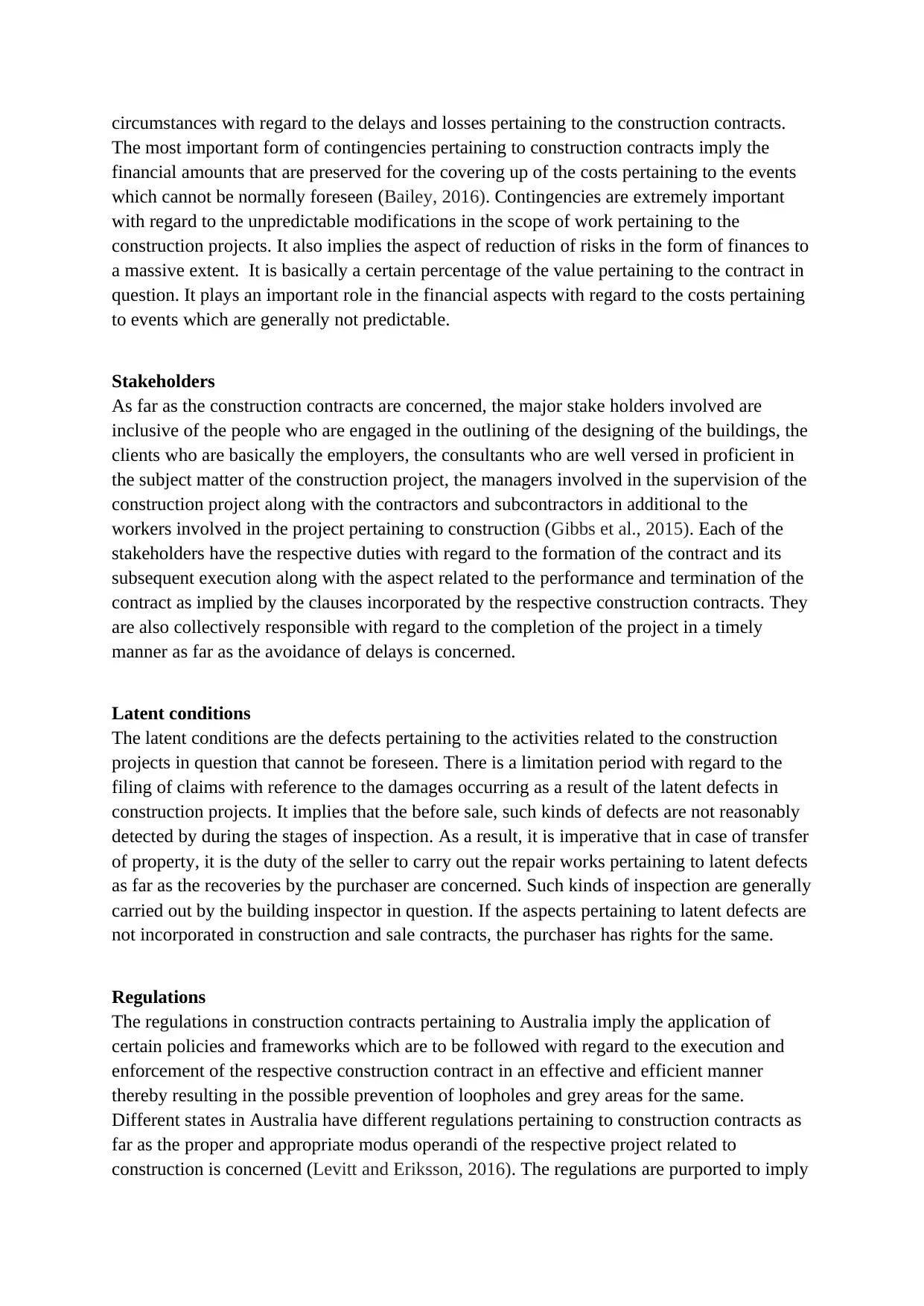
circumstances with regard to the delays and losses pertaining to the construction contracts.
The most important form of contingencies pertaining to construction contracts imply the
financial amounts that are preserved for the covering up of the costs pertaining to the events
which cannot be normally foreseen (Bailey, 2016). Contingencies are extremely important
with regard to the unpredictable modifications in the scope of work pertaining to the
construction projects. It also implies the aspect of reduction of risks in the form of finances to
a massive extent. It is basically a certain percentage of the value pertaining to the contract in
question. It plays an important role in the financial aspects with regard to the costs pertaining
to events which are generally not predictable.
Stakeholders
As far as the construction contracts are concerned, the major stake holders involved are
inclusive of the people who are engaged in the outlining of the designing of the buildings, the
clients who are basically the employers, the consultants who are well versed in proficient in
the subject matter of the construction project, the managers involved in the supervision of the
construction project along with the contractors and subcontractors in additional to the
workers involved in the project pertaining to construction (Gibbs et al., 2015). Each of the
stakeholders have the respective duties with regard to the formation of the contract and its
subsequent execution along with the aspect related to the performance and termination of the
contract as implied by the clauses incorporated by the respective construction contracts. They
are also collectively responsible with regard to the completion of the project in a timely
manner as far as the avoidance of delays is concerned.
Latent conditions
The latent conditions are the defects pertaining to the activities related to the construction
projects in question that cannot be foreseen. There is a limitation period with regard to the
filing of claims with reference to the damages occurring as a result of the latent defects in
construction projects. It implies that the before sale, such kinds of defects are not reasonably
detected by during the stages of inspection. As a result, it is imperative that in case of transfer
of property, it is the duty of the seller to carry out the repair works pertaining to latent defects
as far as the recoveries by the purchaser are concerned. Such kinds of inspection are generally
carried out by the building inspector in question. If the aspects pertaining to latent defects are
not incorporated in construction and sale contracts, the purchaser has rights for the same.
Regulations
The regulations in construction contracts pertaining to Australia imply the application of
certain policies and frameworks which are to be followed with regard to the execution and
enforcement of the respective construction contract in an effective and efficient manner
thereby resulting in the possible prevention of loopholes and grey areas for the same.
Different states in Australia have different regulations pertaining to construction contracts as
far as the proper and appropriate modus operandi of the respective project related to
construction is concerned (Levitt and Eriksson, 2016). The regulations are purported to imply
The most important form of contingencies pertaining to construction contracts imply the
financial amounts that are preserved for the covering up of the costs pertaining to the events
which cannot be normally foreseen (Bailey, 2016). Contingencies are extremely important
with regard to the unpredictable modifications in the scope of work pertaining to the
construction projects. It also implies the aspect of reduction of risks in the form of finances to
a massive extent. It is basically a certain percentage of the value pertaining to the contract in
question. It plays an important role in the financial aspects with regard to the costs pertaining
to events which are generally not predictable.
Stakeholders
As far as the construction contracts are concerned, the major stake holders involved are
inclusive of the people who are engaged in the outlining of the designing of the buildings, the
clients who are basically the employers, the consultants who are well versed in proficient in
the subject matter of the construction project, the managers involved in the supervision of the
construction project along with the contractors and subcontractors in additional to the
workers involved in the project pertaining to construction (Gibbs et al., 2015). Each of the
stakeholders have the respective duties with regard to the formation of the contract and its
subsequent execution along with the aspect related to the performance and termination of the
contract as implied by the clauses incorporated by the respective construction contracts. They
are also collectively responsible with regard to the completion of the project in a timely
manner as far as the avoidance of delays is concerned.
Latent conditions
The latent conditions are the defects pertaining to the activities related to the construction
projects in question that cannot be foreseen. There is a limitation period with regard to the
filing of claims with reference to the damages occurring as a result of the latent defects in
construction projects. It implies that the before sale, such kinds of defects are not reasonably
detected by during the stages of inspection. As a result, it is imperative that in case of transfer
of property, it is the duty of the seller to carry out the repair works pertaining to latent defects
as far as the recoveries by the purchaser are concerned. Such kinds of inspection are generally
carried out by the building inspector in question. If the aspects pertaining to latent defects are
not incorporated in construction and sale contracts, the purchaser has rights for the same.
Regulations
The regulations in construction contracts pertaining to Australia imply the application of
certain policies and frameworks which are to be followed with regard to the execution and
enforcement of the respective construction contract in an effective and efficient manner
thereby resulting in the possible prevention of loopholes and grey areas for the same.
Different states in Australia have different regulations pertaining to construction contracts as
far as the proper and appropriate modus operandi of the respective project related to
construction is concerned (Levitt and Eriksson, 2016). The regulations are purported to imply
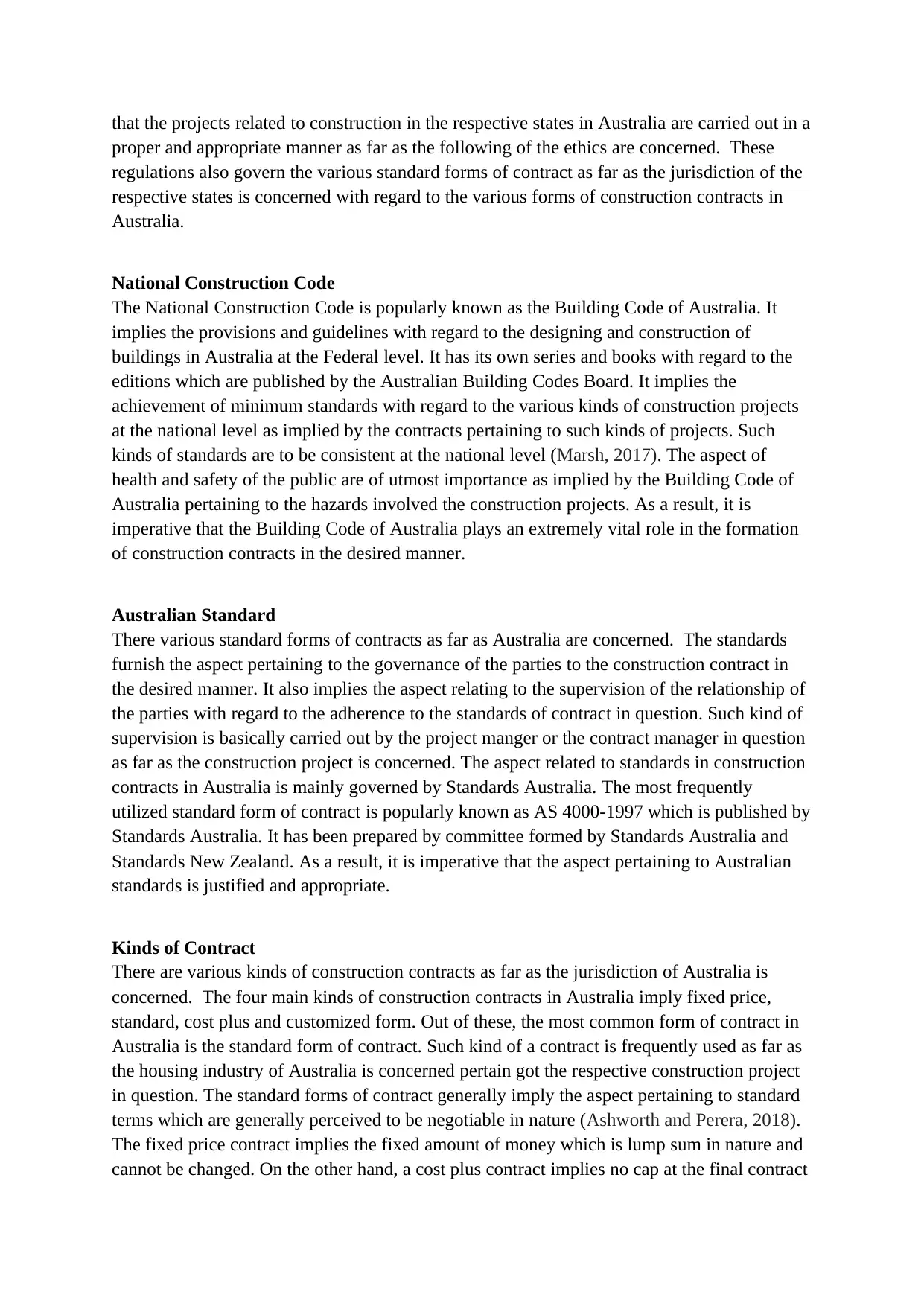
that the projects related to construction in the respective states in Australia are carried out in a
proper and appropriate manner as far as the following of the ethics are concerned. These
regulations also govern the various standard forms of contract as far as the jurisdiction of the
respective states is concerned with regard to the various forms of construction contracts in
Australia.
National Construction Code
The National Construction Code is popularly known as the Building Code of Australia. It
implies the provisions and guidelines with regard to the designing and construction of
buildings in Australia at the Federal level. It has its own series and books with regard to the
editions which are published by the Australian Building Codes Board. It implies the
achievement of minimum standards with regard to the various kinds of construction projects
at the national level as implied by the contracts pertaining to such kinds of projects. Such
kinds of standards are to be consistent at the national level (Marsh, 2017). The aspect of
health and safety of the public are of utmost importance as implied by the Building Code of
Australia pertaining to the hazards involved the construction projects. As a result, it is
imperative that the Building Code of Australia plays an extremely vital role in the formation
of construction contracts in the desired manner.
Australian Standard
There various standard forms of contracts as far as Australia are concerned. The standards
furnish the aspect pertaining to the governance of the parties to the construction contract in
the desired manner. It also implies the aspect relating to the supervision of the relationship of
the parties with regard to the adherence to the standards of contract in question. Such kind of
supervision is basically carried out by the project manger or the contract manager in question
as far as the construction project is concerned. The aspect related to standards in construction
contracts in Australia is mainly governed by Standards Australia. The most frequently
utilized standard form of contract is popularly known as AS 4000-1997 which is published by
Standards Australia. It has been prepared by committee formed by Standards Australia and
Standards New Zealand. As a result, it is imperative that the aspect pertaining to Australian
standards is justified and appropriate.
Kinds of Contract
There are various kinds of construction contracts as far as the jurisdiction of Australia is
concerned. The four main kinds of construction contracts in Australia imply fixed price,
standard, cost plus and customized form. Out of these, the most common form of contract in
Australia is the standard form of contract. Such kind of a contract is frequently used as far as
the housing industry of Australia is concerned pertain got the respective construction project
in question. The standard forms of contract generally imply the aspect pertaining to standard
terms which are generally perceived to be negotiable in nature (Ashworth and Perera, 2018).
The fixed price contract implies the fixed amount of money which is lump sum in nature and
cannot be changed. On the other hand, a cost plus contract implies no cap at the final contract
proper and appropriate manner as far as the following of the ethics are concerned. These
regulations also govern the various standard forms of contract as far as the jurisdiction of the
respective states is concerned with regard to the various forms of construction contracts in
Australia.
National Construction Code
The National Construction Code is popularly known as the Building Code of Australia. It
implies the provisions and guidelines with regard to the designing and construction of
buildings in Australia at the Federal level. It has its own series and books with regard to the
editions which are published by the Australian Building Codes Board. It implies the
achievement of minimum standards with regard to the various kinds of construction projects
at the national level as implied by the contracts pertaining to such kinds of projects. Such
kinds of standards are to be consistent at the national level (Marsh, 2017). The aspect of
health and safety of the public are of utmost importance as implied by the Building Code of
Australia pertaining to the hazards involved the construction projects. As a result, it is
imperative that the Building Code of Australia plays an extremely vital role in the formation
of construction contracts in the desired manner.
Australian Standard
There various standard forms of contracts as far as Australia are concerned. The standards
furnish the aspect pertaining to the governance of the parties to the construction contract in
the desired manner. It also implies the aspect relating to the supervision of the relationship of
the parties with regard to the adherence to the standards of contract in question. Such kind of
supervision is basically carried out by the project manger or the contract manager in question
as far as the construction project is concerned. The aspect related to standards in construction
contracts in Australia is mainly governed by Standards Australia. The most frequently
utilized standard form of contract is popularly known as AS 4000-1997 which is published by
Standards Australia. It has been prepared by committee formed by Standards Australia and
Standards New Zealand. As a result, it is imperative that the aspect pertaining to Australian
standards is justified and appropriate.
Kinds of Contract
There are various kinds of construction contracts as far as the jurisdiction of Australia is
concerned. The four main kinds of construction contracts in Australia imply fixed price,
standard, cost plus and customized form. Out of these, the most common form of contract in
Australia is the standard form of contract. Such kind of a contract is frequently used as far as
the housing industry of Australia is concerned pertain got the respective construction project
in question. The standard forms of contract generally imply the aspect pertaining to standard
terms which are generally perceived to be negotiable in nature (Ashworth and Perera, 2018).
The fixed price contract implies the fixed amount of money which is lump sum in nature and
cannot be changed. On the other hand, a cost plus contract implies no cap at the final contract
⊘ This is a preview!⊘
Do you want full access?
Subscribe today to unlock all pages.

Trusted by 1+ million students worldwide
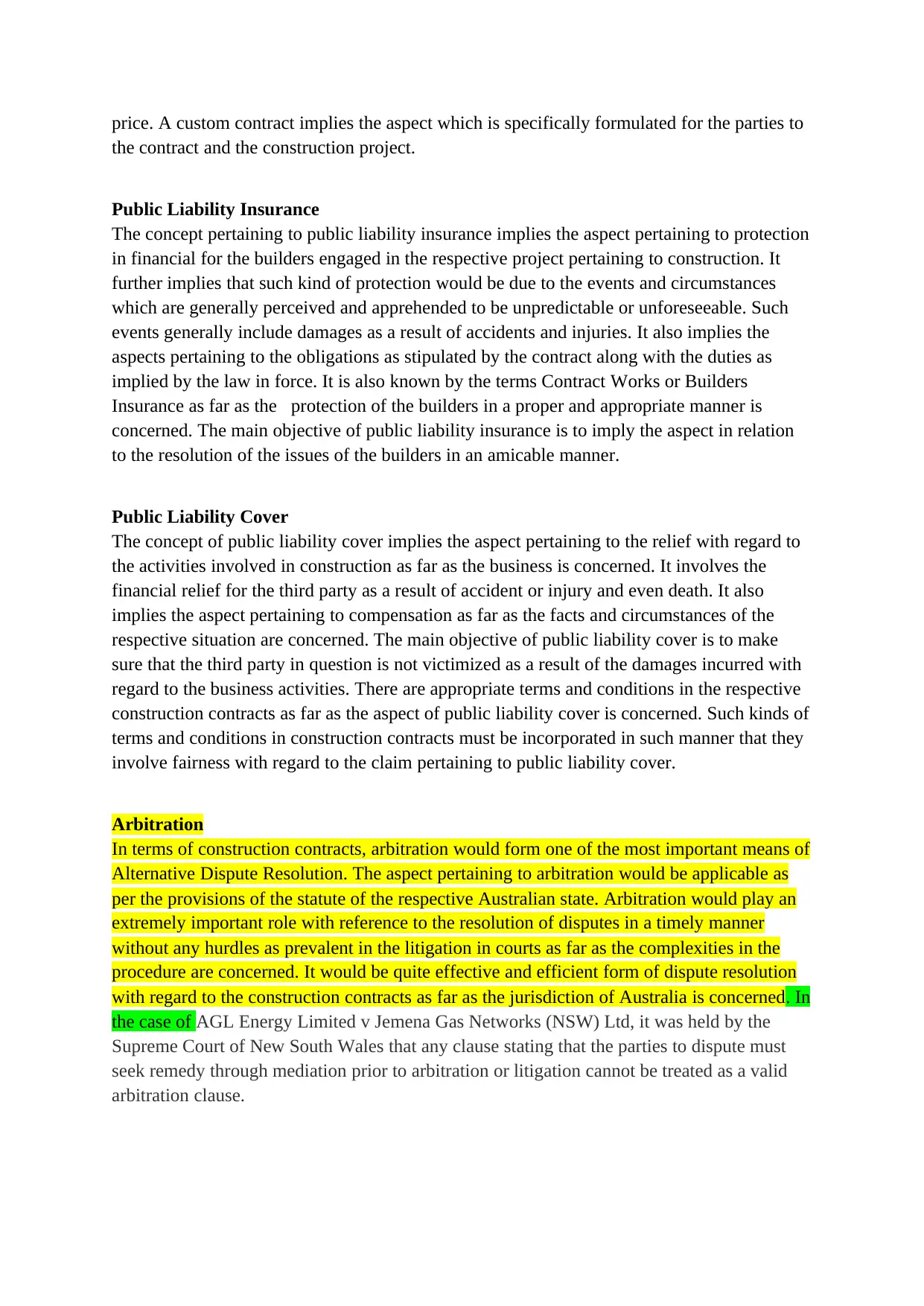
price. A custom contract implies the aspect which is specifically formulated for the parties to
the contract and the construction project.
Public Liability Insurance
The concept pertaining to public liability insurance implies the aspect pertaining to protection
in financial for the builders engaged in the respective project pertaining to construction. It
further implies that such kind of protection would be due to the events and circumstances
which are generally perceived and apprehended to be unpredictable or unforeseeable. Such
events generally include damages as a result of accidents and injuries. It also implies the
aspects pertaining to the obligations as stipulated by the contract along with the duties as
implied by the law in force. It is also known by the terms Contract Works or Builders
Insurance as far as the protection of the builders in a proper and appropriate manner is
concerned. The main objective of public liability insurance is to imply the aspect in relation
to the resolution of the issues of the builders in an amicable manner.
Public Liability Cover
The concept of public liability cover implies the aspect pertaining to the relief with regard to
the activities involved in construction as far as the business is concerned. It involves the
financial relief for the third party as a result of accident or injury and even death. It also
implies the aspect pertaining to compensation as far as the facts and circumstances of the
respective situation are concerned. The main objective of public liability cover is to make
sure that the third party in question is not victimized as a result of the damages incurred with
regard to the business activities. There are appropriate terms and conditions in the respective
construction contracts as far as the aspect of public liability cover is concerned. Such kinds of
terms and conditions in construction contracts must be incorporated in such manner that they
involve fairness with regard to the claim pertaining to public liability cover.
Arbitration
In terms of construction contracts, arbitration would form one of the most important means of
Alternative Dispute Resolution. The aspect pertaining to arbitration would be applicable as
per the provisions of the statute of the respective Australian state. Arbitration would play an
extremely important role with reference to the resolution of disputes in a timely manner
without any hurdles as prevalent in the litigation in courts as far as the complexities in the
procedure are concerned. It would be quite effective and efficient form of dispute resolution
with regard to the construction contracts as far as the jurisdiction of Australia is concerned. In
the case of AGL Energy Limited v Jemena Gas Networks (NSW) Ltd, it was held by the
Supreme Court of New South Wales that any clause stating that the parties to dispute must
seek remedy through mediation prior to arbitration or litigation cannot be treated as a valid
arbitration clause.
the contract and the construction project.
Public Liability Insurance
The concept pertaining to public liability insurance implies the aspect pertaining to protection
in financial for the builders engaged in the respective project pertaining to construction. It
further implies that such kind of protection would be due to the events and circumstances
which are generally perceived and apprehended to be unpredictable or unforeseeable. Such
events generally include damages as a result of accidents and injuries. It also implies the
aspects pertaining to the obligations as stipulated by the contract along with the duties as
implied by the law in force. It is also known by the terms Contract Works or Builders
Insurance as far as the protection of the builders in a proper and appropriate manner is
concerned. The main objective of public liability insurance is to imply the aspect in relation
to the resolution of the issues of the builders in an amicable manner.
Public Liability Cover
The concept of public liability cover implies the aspect pertaining to the relief with regard to
the activities involved in construction as far as the business is concerned. It involves the
financial relief for the third party as a result of accident or injury and even death. It also
implies the aspect pertaining to compensation as far as the facts and circumstances of the
respective situation are concerned. The main objective of public liability cover is to make
sure that the third party in question is not victimized as a result of the damages incurred with
regard to the business activities. There are appropriate terms and conditions in the respective
construction contracts as far as the aspect of public liability cover is concerned. Such kinds of
terms and conditions in construction contracts must be incorporated in such manner that they
involve fairness with regard to the claim pertaining to public liability cover.
Arbitration
In terms of construction contracts, arbitration would form one of the most important means of
Alternative Dispute Resolution. The aspect pertaining to arbitration would be applicable as
per the provisions of the statute of the respective Australian state. Arbitration would play an
extremely important role with reference to the resolution of disputes in a timely manner
without any hurdles as prevalent in the litigation in courts as far as the complexities in the
procedure are concerned. It would be quite effective and efficient form of dispute resolution
with regard to the construction contracts as far as the jurisdiction of Australia is concerned. In
the case of AGL Energy Limited v Jemena Gas Networks (NSW) Ltd, it was held by the
Supreme Court of New South Wales that any clause stating that the parties to dispute must
seek remedy through mediation prior to arbitration or litigation cannot be treated as a valid
arbitration clause.
Paraphrase This Document
Need a fresh take? Get an instant paraphrase of this document with our AI Paraphraser
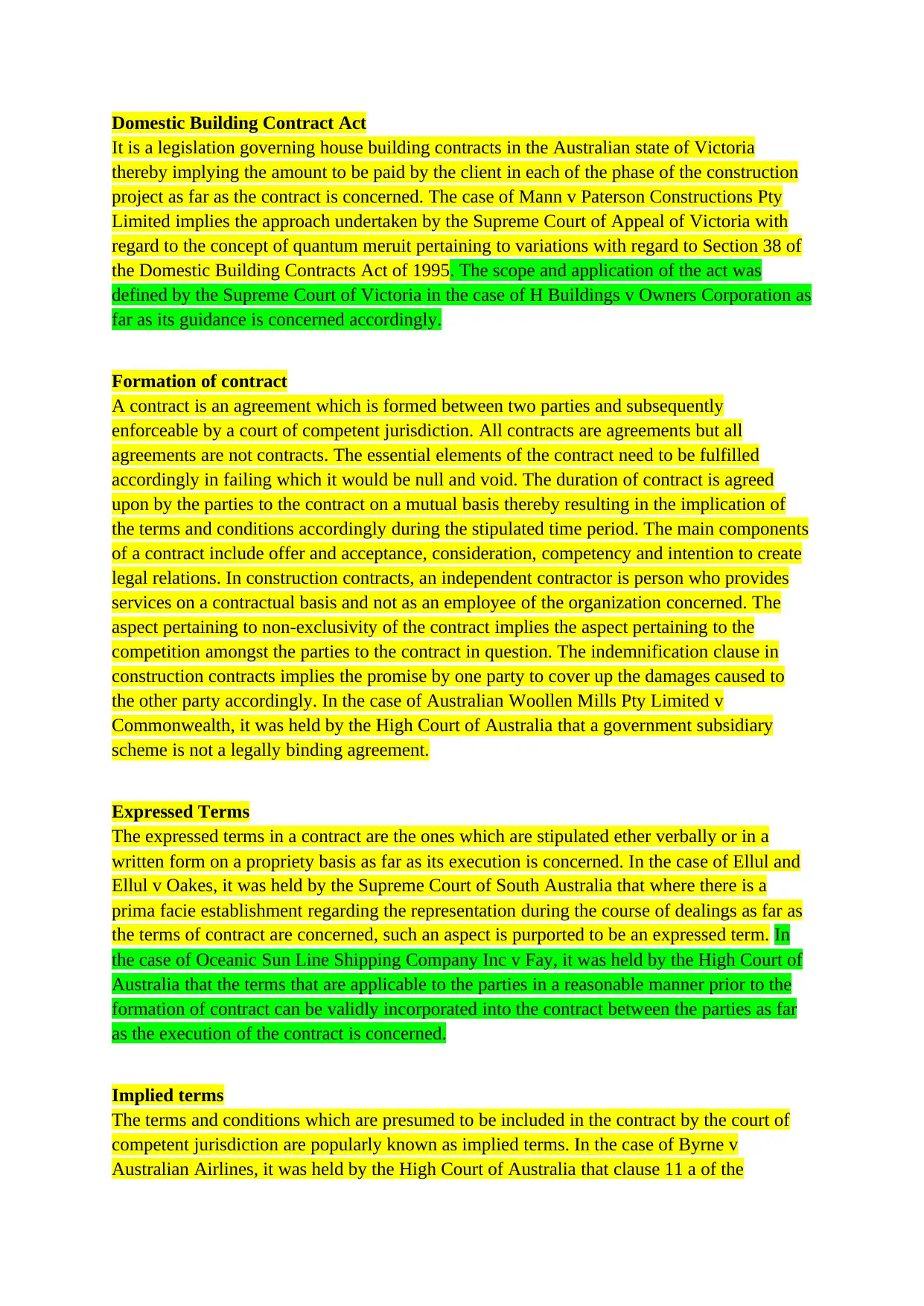
Domestic Building Contract Act
It is a legislation governing house building contracts in the Australian state of Victoria
thereby implying the amount to be paid by the client in each of the phase of the construction
project as far as the contract is concerned. The case of Mann v Paterson Constructions Pty
Limited implies the approach undertaken by the Supreme Court of Appeal of Victoria with
regard to the concept of quantum meruit pertaining to variations with regard to Section 38 of
the Domestic Building Contracts Act of 1995. The scope and application of the act was
defined by the Supreme Court of Victoria in the case of H Buildings v Owners Corporation as
far as its guidance is concerned accordingly.
Formation of contract
A contract is an agreement which is formed between two parties and subsequently
enforceable by a court of competent jurisdiction. All contracts are agreements but all
agreements are not contracts. The essential elements of the contract need to be fulfilled
accordingly in failing which it would be null and void. The duration of contract is agreed
upon by the parties to the contract on a mutual basis thereby resulting in the implication of
the terms and conditions accordingly during the stipulated time period. The main components
of a contract include offer and acceptance, consideration, competency and intention to create
legal relations. In construction contracts, an independent contractor is person who provides
services on a contractual basis and not as an employee of the organization concerned. The
aspect pertaining to non-exclusivity of the contract implies the aspect pertaining to the
competition amongst the parties to the contract in question. The indemnification clause in
construction contracts implies the promise by one party to cover up the damages caused to
the other party accordingly. In the case of Australian Woollen Mills Pty Limited v
Commonwealth, it was held by the High Court of Australia that a government subsidiary
scheme is not a legally binding agreement.
Expressed Terms
The expressed terms in a contract are the ones which are stipulated ether verbally or in a
written form on a propriety basis as far as its execution is concerned. In the case of Ellul and
Ellul v Oakes, it was held by the Supreme Court of South Australia that where there is a
prima facie establishment regarding the representation during the course of dealings as far as
the terms of contract are concerned, such an aspect is purported to be an expressed term. In
the case of Oceanic Sun Line Shipping Company Inc v Fay, it was held by the High Court of
Australia that the terms that are applicable to the parties in a reasonable manner prior to the
formation of contract can be validly incorporated into the contract between the parties as far
as the execution of the contract is concerned.
Implied terms
The terms and conditions which are presumed to be included in the contract by the court of
competent jurisdiction are popularly known as implied terms. In the case of Byrne v
Australian Airlines, it was held by the High Court of Australia that clause 11 a of the
It is a legislation governing house building contracts in the Australian state of Victoria
thereby implying the amount to be paid by the client in each of the phase of the construction
project as far as the contract is concerned. The case of Mann v Paterson Constructions Pty
Limited implies the approach undertaken by the Supreme Court of Appeal of Victoria with
regard to the concept of quantum meruit pertaining to variations with regard to Section 38 of
the Domestic Building Contracts Act of 1995. The scope and application of the act was
defined by the Supreme Court of Victoria in the case of H Buildings v Owners Corporation as
far as its guidance is concerned accordingly.
Formation of contract
A contract is an agreement which is formed between two parties and subsequently
enforceable by a court of competent jurisdiction. All contracts are agreements but all
agreements are not contracts. The essential elements of the contract need to be fulfilled
accordingly in failing which it would be null and void. The duration of contract is agreed
upon by the parties to the contract on a mutual basis thereby resulting in the implication of
the terms and conditions accordingly during the stipulated time period. The main components
of a contract include offer and acceptance, consideration, competency and intention to create
legal relations. In construction contracts, an independent contractor is person who provides
services on a contractual basis and not as an employee of the organization concerned. The
aspect pertaining to non-exclusivity of the contract implies the aspect pertaining to the
competition amongst the parties to the contract in question. The indemnification clause in
construction contracts implies the promise by one party to cover up the damages caused to
the other party accordingly. In the case of Australian Woollen Mills Pty Limited v
Commonwealth, it was held by the High Court of Australia that a government subsidiary
scheme is not a legally binding agreement.
Expressed Terms
The expressed terms in a contract are the ones which are stipulated ether verbally or in a
written form on a propriety basis as far as its execution is concerned. In the case of Ellul and
Ellul v Oakes, it was held by the Supreme Court of South Australia that where there is a
prima facie establishment regarding the representation during the course of dealings as far as
the terms of contract are concerned, such an aspect is purported to be an expressed term. In
the case of Oceanic Sun Line Shipping Company Inc v Fay, it was held by the High Court of
Australia that the terms that are applicable to the parties in a reasonable manner prior to the
formation of contract can be validly incorporated into the contract between the parties as far
as the execution of the contract is concerned.
Implied terms
The terms and conditions which are presumed to be included in the contract by the court of
competent jurisdiction are popularly known as implied terms. In the case of Byrne v
Australian Airlines, it was held by the High Court of Australia that clause 11 a of the
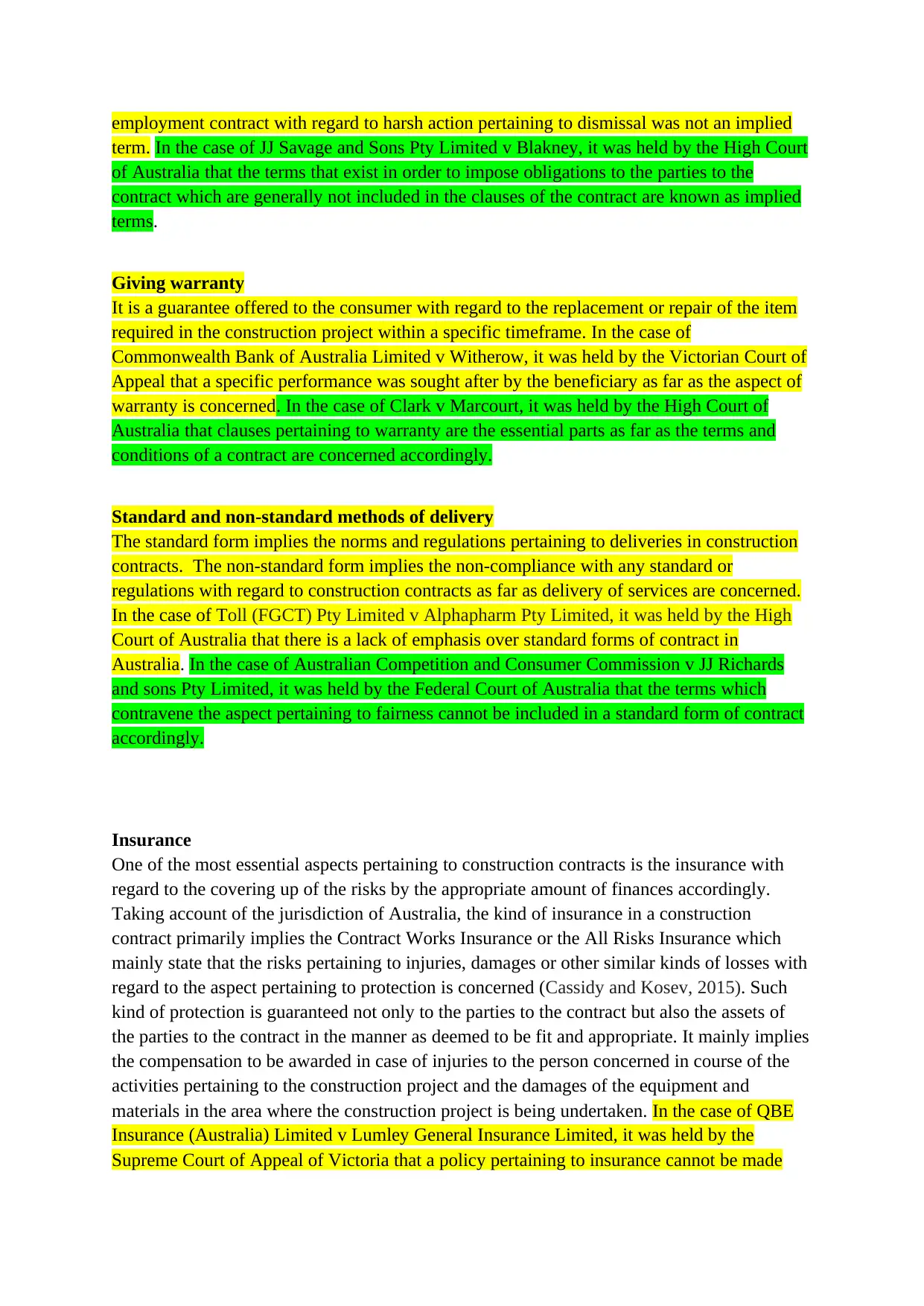
employment contract with regard to harsh action pertaining to dismissal was not an implied
term. In the case of JJ Savage and Sons Pty Limited v Blakney, it was held by the High Court
of Australia that the terms that exist in order to impose obligations to the parties to the
contract which are generally not included in the clauses of the contract are known as implied
terms.
Giving warranty
It is a guarantee offered to the consumer with regard to the replacement or repair of the item
required in the construction project within a specific timeframe. In the case of
Commonwealth Bank of Australia Limited v Witherow, it was held by the Victorian Court of
Appeal that a specific performance was sought after by the beneficiary as far as the aspect of
warranty is concerned. In the case of Clark v Marcourt, it was held by the High Court of
Australia that clauses pertaining to warranty are the essential parts as far as the terms and
conditions of a contract are concerned accordingly.
Standard and non-standard methods of delivery
The standard form implies the norms and regulations pertaining to deliveries in construction
contracts. The non-standard form implies the non-compliance with any standard or
regulations with regard to construction contracts as far as delivery of services are concerned.
In the case of Toll (FGCT) Pty Limited v Alphapharm Pty Limited, it was held by the High
Court of Australia that there is a lack of emphasis over standard forms of contract in
Australia. In the case of Australian Competition and Consumer Commission v JJ Richards
and sons Pty Limited, it was held by the Federal Court of Australia that the terms which
contravene the aspect pertaining to fairness cannot be included in a standard form of contract
accordingly.
Insurance
One of the most essential aspects pertaining to construction contracts is the insurance with
regard to the covering up of the risks by the appropriate amount of finances accordingly.
Taking account of the jurisdiction of Australia, the kind of insurance in a construction
contract primarily implies the Contract Works Insurance or the All Risks Insurance which
mainly state that the risks pertaining to injuries, damages or other similar kinds of losses with
regard to the aspect pertaining to protection is concerned (Cassidy and Kosev, 2015). Such
kind of protection is guaranteed not only to the parties to the contract but also the assets of
the parties to the contract in the manner as deemed to be fit and appropriate. It mainly implies
the compensation to be awarded in case of injuries to the person concerned in course of the
activities pertaining to the construction project and the damages of the equipment and
materials in the area where the construction project is being undertaken. In the case of QBE
Insurance (Australia) Limited v Lumley General Insurance Limited, it was held by the
Supreme Court of Appeal of Victoria that a policy pertaining to insurance cannot be made
term. In the case of JJ Savage and Sons Pty Limited v Blakney, it was held by the High Court
of Australia that the terms that exist in order to impose obligations to the parties to the
contract which are generally not included in the clauses of the contract are known as implied
terms.
Giving warranty
It is a guarantee offered to the consumer with regard to the replacement or repair of the item
required in the construction project within a specific timeframe. In the case of
Commonwealth Bank of Australia Limited v Witherow, it was held by the Victorian Court of
Appeal that a specific performance was sought after by the beneficiary as far as the aspect of
warranty is concerned. In the case of Clark v Marcourt, it was held by the High Court of
Australia that clauses pertaining to warranty are the essential parts as far as the terms and
conditions of a contract are concerned accordingly.
Standard and non-standard methods of delivery
The standard form implies the norms and regulations pertaining to deliveries in construction
contracts. The non-standard form implies the non-compliance with any standard or
regulations with regard to construction contracts as far as delivery of services are concerned.
In the case of Toll (FGCT) Pty Limited v Alphapharm Pty Limited, it was held by the High
Court of Australia that there is a lack of emphasis over standard forms of contract in
Australia. In the case of Australian Competition and Consumer Commission v JJ Richards
and sons Pty Limited, it was held by the Federal Court of Australia that the terms which
contravene the aspect pertaining to fairness cannot be included in a standard form of contract
accordingly.
Insurance
One of the most essential aspects pertaining to construction contracts is the insurance with
regard to the covering up of the risks by the appropriate amount of finances accordingly.
Taking account of the jurisdiction of Australia, the kind of insurance in a construction
contract primarily implies the Contract Works Insurance or the All Risks Insurance which
mainly state that the risks pertaining to injuries, damages or other similar kinds of losses with
regard to the aspect pertaining to protection is concerned (Cassidy and Kosev, 2015). Such
kind of protection is guaranteed not only to the parties to the contract but also the assets of
the parties to the contract in the manner as deemed to be fit and appropriate. It mainly implies
the compensation to be awarded in case of injuries to the person concerned in course of the
activities pertaining to the construction project and the damages of the equipment and
materials in the area where the construction project is being undertaken. In the case of QBE
Insurance (Australia) Limited v Lumley General Insurance Limited, it was held by the
Supreme Court of Appeal of Victoria that a policy pertaining to insurance cannot be made
⊘ This is a preview!⊘
Do you want full access?
Subscribe today to unlock all pages.

Trusted by 1+ million students worldwide
1 out of 20
Related Documents
Your All-in-One AI-Powered Toolkit for Academic Success.
+13062052269
info@desklib.com
Available 24*7 on WhatsApp / Email
![[object Object]](/_next/static/media/star-bottom.7253800d.svg)
Unlock your academic potential
Copyright © 2020–2025 A2Z Services. All Rights Reserved. Developed and managed by ZUCOL.



